EDITH CAVELL STORY
Contents:
click on theme to see the textTheme 1 – Before 1907. Edith Cavell's life before she arrived in Belgium to open the nursing school
Theme 2 – 1906 to 1914. Edith Cavell's contribution to nursing in Belgium
Theme 3 – 1914 to 1915. Edith Cavell and the networks
Theme 4 – The impact of Edith Cavell's execution
Theme 5 – Events after World War One
Theme 6 – Memorials to Edith Cavell throughout the world
Theme 1 – Before 1907. Edith Cavell's life before she arrived in Belgium to open the nursing school
| 1865 |  Edith Louisa Cavell born in Swardeston (near Norwich), Norfolk, United Kingdom. Her parents were The Reverend Frederick Cavell and Louisa Sophia. Edith was the eldest of four children. Here siblings were Florence, Lilian and John. Edith Louisa Cavell born in Swardeston (near Norwich), Norfolk, United Kingdom. Her parents were The Reverend Frederick Cavell and Louisa Sophia. Edith was the eldest of four children. Here siblings were Florence, Lilian and John.Cavell home Swardeston |
|
| 1865 to 1881 TOP |
 Edith Cavell lived and was educated in The Vicarage at Swardeston. She did not attend the local school. During this time Edith became quite an accomplished artist specialising in painting flowers, much inspired by Landseer, a popular Victorian artist. She also enjoyed ice-skating in winter. Edith Cavell is quoted to have said that she would like to be buried in Westminster Abbey. Edith Cavell lived and was educated in The Vicarage at Swardeston. She did not attend the local school. During this time Edith became quite an accomplished artist specialising in painting flowers, much inspired by Landseer, a popular Victorian artist. She also enjoyed ice-skating in winter. Edith Cavell is quoted to have said that she would like to be buried in Westminster Abbey.Edith Cavell as a teenager, c. 1880 |
|
| 1881 to 1884 | Edith finally goes to school at Norwich High School, and then three boarding schools in Kensington (London), Clevedon (Bristol) and Laurel Court School (Peterborough). At Laurel Court she learned to speak French, for which she showed talent, and was subsequently recommended by the head teacher, Margaret Gibson, for the post of governess to the François family in Brussels in 1890. | |
| 1886 | Edith's first job as a governess was with a clergy household in the village of Steeple Bumpstead then with the Gurney family at Keswick New Hall in a near-by village. She is remembered as being full of fun, always smiling and wonderfully kind to the children in her charge. | |
| 1888 TOP |
Edith is left a small legacy and decides to travel to the continent. She visits Austria and Bavaria, and is very impressed with a free hospital run by a Dr. Wolfenberg. She endows the hospital with some of her legacy and returns with a growing interest in nursing. | |
| 1890 to 1895 | Recommended by her former teacher Margaret Gibson Edith Cavell accepts gladly the offer of the post of governess to the François family in 1890 who lived in Brussels, Avenue Louise 154. This move to Belgium was important in several aspects. She developed her capacity as a teacher, pursued her talent as an artist, perfected her French and built a love for Brussels and Belgium. M and Mme François had four children, Marguerite (thirteen), Georges (twelve), Hélène (eight) and Eveline (three). In 1890 four rows of horse-chestnut trees stretched the length of the Avenue Louise and Edith and the François family would observe The King Leopold pass the house on his way to the Bois de la Cambre. Mme Hélène François is said to have described Edith as very kind but very strict and with the habit of organizing interesting activities such as tea parties where the children acted as hosts and performed charades. Edith continued her sketching and painting activities at this time. Edith told the François family that she could never tell a lie. If a visitor came to the door and Mme François asked Edith to tell the visitor that she was not at home Edith refused to lie on her behalf. The François family spent time at a country chateau near the Dutch/German border where the children spent most of their time with Edith. They later recalled that she was strict but kind, had a great love of the country and animals, particularly dogs and enjoyed painting and drawing. During this period Edith spent summer holidays back home and developed a romantic attachment with her second cousin, Eddie. She might have married Eddie but he rejected marriage due to an inherited nervous condition. They appear to have been in love and Edith never forgot him. She wrote in her copy of "The Imitation of Christ" – "with love to E D Cavell" on the day of her execution. |
|
| TOP | 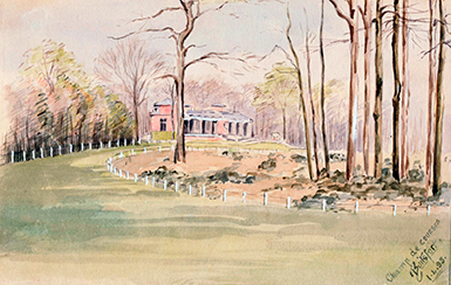 |
 |
| TOP | Edith Cavell painting of the racecourse at Boitsfort, Brussels – 1893 | Edith Cavell painting of the chapel at Hugoumont Waterloo – 1892 or 1893 |
| 1895 | Edith returns to Swardeston to nurse her sick father. The experience of nursing her father convinces Edith that a career in nursing is the sort of profession that she is looking for. | |
| 1896 | Edith spends few months spent at the Fountains Fever Hospital, London, to see how suited she is to nursing. Edith is accepted for nursing training at the Royal London Hospital under Eva Luckes. | |
| 1897 | A typhoid epidemic breaks out in Maidstone, Kent. Edith goes with five other nurses to help. Only 132 people die out of the 1,700 who contract the disease. Edith receives the Maidstone Medal for her work. | |
| 1898 to 1906 | 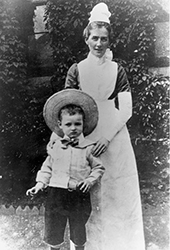 She finishes her nursing training then works variously as a Night Supervisor at St Pancras infirmary for the destitute, as assistant matron at Shoreditch Infirmary and at the Manchester and Salford Sick Poor and Private Nursing Institution as a nurse at one of the Queen's District Nursing Homes. She took over as Matron for a short period, a position that she found "tiring". She finishes her nursing training then works variously as a Night Supervisor at St Pancras infirmary for the destitute, as assistant matron at Shoreditch Infirmary and at the Manchester and Salford Sick Poor and Private Nursing Institution as a nurse at one of the Queen's District Nursing Homes. She took over as Matron for a short period, a position that she found "tiring".Edith Cavell at Shoreditch with a child, c. 1904 |
|
| 1906 | Dr. Antoine Depage, much impressed by the training of British nurses and of the health care of Florence Nightingale during the Crimean and Balkans wars, decides to open training school for nurses in Brussels. | |
| TOP | ||
Theme 2 – 1906 to 1914. Edith Cavell's contribution to nursing in Belgium
| 1907 to 1908 | In September 1907 Edith returns to Brussels, at the request of Dr. Antoine Depage, to nurse a child patient of his. In October, Depage opens his pioneering "L'École Belge d'Infirmières Diplômées", based in his Berkendael Institute. He asks Edith Cavell to run it. The school is based at 173 and 175, rue de la Culture (now rue Franz Merjay 147 and 149) in two adjoining houses. Later two more houses are added (numbers 177 and 179) as well as bedrooms for the trainee nurses in numbers 4, 5 and 7. From 1907 to 1908 the first pupils are taught by experienced nurses from London. The first students are a mix of ladies and young girls.This part of Brussels is a new quarter in front of a large sandy plain with views to the "avenue Longchamp", now "avenue Winston Churchill. In the first year the "Institut de Berkendael" treats some 57 patients. There are 20 bedrooms at a price of between 5 and 8 francs. There is no running water in the bedrooms and there is one operating theatre. Marie Depage, Antoine Depage's wife, assists Edith Cavell in her work. Finance for the venture is provided in part by Mme Ernest Solvay and Mme Charles Graux. Many other private donations are also received. Starting in 1908 a "Certificate of Competence" is awarded to the "graduate nurses". An official diploma is established in 1913, updated in 1921, by Royal Decree. | |||
| TOP | 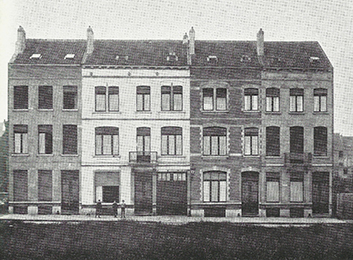 |
 |
||
| Rue de la Culture, Brussels (Now, Rue Franz Merjay) 1907 | Rue Franz Merjay - Today | |||
| 1909 to 1910 |  During this period the nursing school has 23 pupils. The City of Brussels, the St Gilles Hospital and the Jumet Hospital all request the services of the Edith Cavell trained nurses. During this period the nursing school has 23 pupils. The City of Brussels, the St Gilles Hospital and the Jumet Hospital all request the services of the Edith Cavell trained nurses.Edith Cavell and Antoine Depage 1910 |
|||
| 1912 TOP |
 Edith's training programme produces well-qualified nurses. By this time Edith's school is providing nurses for three hospitals, 24 communal schools and 13 kindergartens. In 1912 a company is set up to raise new capital to purchase land situated between the "rue de Bruxelles" (now the rue Edith Cavell) and the "rue de l'Ecole" (now rue Marie Depage). The architect Dewin is appointed to design a new hospital. The central building will house the general services (kitchen, administrative offices, laundry) and an operating theatre. The hospital wing on the rue Edith Cavell will house the new Nurses Training School and the student bedrooms, eventually 50 in number. The wing on the rue Marie Depage will provide some 20 bedrooms for patients. The building work is completed in 1914 and the official opening takes place in 1915. Edith's training programme produces well-qualified nurses. By this time Edith's school is providing nurses for three hospitals, 24 communal schools and 13 kindergartens. In 1912 a company is set up to raise new capital to purchase land situated between the "rue de Bruxelles" (now the rue Edith Cavell) and the "rue de l'Ecole" (now rue Marie Depage). The architect Dewin is appointed to design a new hospital. The central building will house the general services (kitchen, administrative offices, laundry) and an operating theatre. The hospital wing on the rue Edith Cavell will house the new Nurses Training School and the student bedrooms, eventually 50 in number. The wing on the rue Marie Depage will provide some 20 bedrooms for patients. The building work is completed in 1914 and the official opening takes place in 1915.Medal Ecole Belge des Infirmières |
|||
| 1913 - 1914 | Despite her own early record of unpunctuality, Edith kept a watch before her at breakfast and any unfortunate woman more than two minutes late would forfeit two hours of her spare time. The work "ethic" was quickly established, despite some resistance from the middle classes. Edith writes home... "The old idea that it is a disgrace for women to work is still held in Belgium and women of good birth and education still think they lose face by earning their own living". However, when the Queen Elizabeth of the Belgians broke her arm and sent to the school for a trained nurse, suddenly the status of the school was assured. By late 1913 and early 1914, in addition to her many administrative and nursing duties, Edith was giving four lectures a week to doctors and nurses, was caring for a friend's daughter who was a morphine addict and looking after her two dogs, Don and Jack. | |||
| TOP | 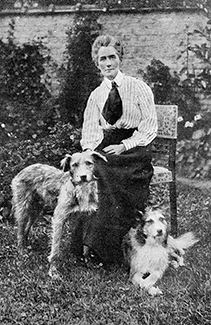 |
Edith Cavell with Don and Jack | ||
Theme 3 – 1914 to 1915. Edith Cavell and the networks
| 1914 – the outbreak of war |
28th June - Archduke Ferdinand, heir to the Austro-Hungarian throne, is assassinated in Sarajevo, Bosnia. Exactly a month later, as a result of the assassination, Austro-Hungarian troops invade Serbia. Edith is in Norfolk, visiting her widowed mother. 1st August - To support its ally Austria-Hungary, Germany declares war on Russia, Serbia's ally. France, Russia's ally, finds itself at war with Germany and Austria-Hungary. Edith returns to Brussels, feeling that her nursing skills will be required more than ever. Her return is very much against the wishes of her family and friends in Norfolk. She says "At a time like this I am more needed than ever". 3rd August – Edith is back in Brussels and sends home the Dutch and German students. She impresses on the others that their first duty was to care for the wounded, irrespective of nationality. 4th August - Germany invades Belgium and Britain declares war on Germany. WW1 sees Britain, France and Russia on one side (the Allies), and Germany, Austro-Hungary and Turkey on the other (the Central Powers). Edith stays in Belgium. 20th and 21st August - German soldiers invade and occupy Brussels. The wounded of all nationalities start to pour into Edith's clinic. The clinic becomes a Red Cross Hospital for wounded of all nationalities - the nurses must not take part in the war on either side. Queen Elizabeth of Belgium opened the Royal Palace for the war wounded, mostly German. Sixty British nurses were sent home. Edith Cavell and her chief assistant, Miss Wilkins, remained. 23rd August - The Battle of Mons begins. The British are heavily outnumbered and retreat. In the confusion, many soldiers are cut off behind enemy lines. Edith hears of Allied soldiers being shot by the Germans, along with the locals who were sheltering them. |
| 1914-1915 – the escape organisation TOP |
The initial German advance in Belgium was successful and the British retreated from Mons and the French were driven back, many in both armies being cut off. In the Autumn of 1914, two stranded British soldiers found their way to Nurse Cavell's training school and were sheltered for two weeks, despite the danger involved. Others followed, all of them spirited away to neutral territory in Holland. One from the 1st Battalion of the Norfolk Regiment recognised a print of Norwich Cathedral on the wall of her office; she was always delighted to receive someone from her beloved Norfolk, asking a private Arthur Wood to take home her Bible and a letter for her mother. Progressively an 'underground' lifeline was established, assisted by Prince Reginald de Croÿ and his sister Princess Marie, at their home, Chateau de Bellignies in France near Maubeuge. Guides were organised by Philippe Baucq, a Brussels architect, and some 200 allied soldiers helped to escape. (The password was 'Yorc' - Croÿ backwards). This organisation lasted for about nine months, despite the risks. All those involved knew they could be shot for harbouring allied soldiers. Edith also faced a moral dilemma. As a 'protected' member of the Red Cross, she should have remained aloof. She was, however, prepared to sacrifice her conscience for the sake of her fellow men. To her, the protection, the concealment and the smuggling away of hunted men was as humanitarian an act as the tending of the sick and wounded. Edith was prepared to face what she understood to be the just consequences. By August 1915 a Belgian 'collaborator' had passed through Edith's hands. The school was searched while a soldier slipped out through the back garden, Nurse Cavell remained calm - no incriminating papers were ever found (her Diary she sewed up in a cushion). Edith was too thorough and she had even managed to keep her 'underground' activities from her nurses so as not to incriminate them. Her colleagues, Elizabeth Wilkins and Jacqueline Van Til said that she had grown older, more withdrawn and silent and more determined. Alongside the escape organisation and the increasing difficulties in providing reliable guides and sufficient money for the escapes, Edith had to run the training school in Ixelles and to supervise the building of the new school, which was going on in Uccle. It was some time before she realised that helping fugitives had become an offence punishable by death. She could not, however, be persuaded to give up these activities. Dr. Depage was working on the other side of the war front and his wife Marie had left for America to raise money. The main burden of running the school fell on Edith Cavell and she was increasingly at odds with the of the School who became alarmed at the suspicion aroused in Germans and informers by her escape work. |
| 1915 – 7th May TOP |
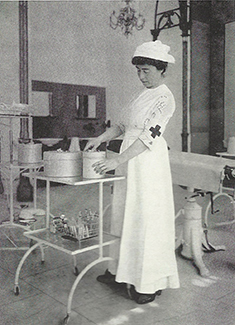 Marie Depage, the wife of the Belgian doctor who initiated the school, is drowned when the Luisitania is sunk by a German U-boat killing about 1,198 of the 1,959 people on board. Marie was returning from America where she had been raising funds for the "Océan" field hospital, which Antoine Depage had established at De Panne in Belgium to treat wounded soldiers. Marie Depage, the wife of the Belgian doctor who initiated the school, is drowned when the Luisitania is sunk by a German U-boat killing about 1,198 of the 1,959 people on board. Marie was returning from America where she had been raising funds for the "Océan" field hospital, which Antoine Depage had established at De Panne in Belgium to treat wounded soldiers.Marie Depage August 1914 |
| 1915 – arrest and imprisonment TOP |
Edith was very shaken and saddened at the news of Marie Depage's death. At about the same time the Secret Police began to close in on the escape operations. They wished to frighten and intimidate but not to make arrests before they could discover the full extent of the organisation and take in everyone concerned. These activities went on for about three months creating fear and tension in the school and in the escape organisation. July 1915 – Philippe Baucq is arrested. 5th August 1915 - Edith Cavell is arrested. In total 35 individuals were arrested in the following weeks, including Marie de Croÿ, Hermann Capiau, Louise Thulliez, Countess Jeanne de Belleville, Louis Séverin and Georges Hostelet. They were later classified into three categories; those who acted as guides, organisers and liaison officers; the chemists who helped developing photographs and making out identity papers; and those who gave accommodation to the escapers. Some members of the group served in more than one capacity. Around 8th August 1915 - After 72 hours' interrogation Edith is tricked into making a confession. The interrogators tell her that they already have the information they need and that she can only save her friends if she makes a full confession. Edith believes them. 10th August 1915 – Edith Cavell is transferred from police headquarters to the St Gilles prison in Brussels. 31st August 1915 - The American Ambassador in Belgium, Brand Whitlock, writes to Baron von der Lancken, German political minister in Brussels, to ask if it is true that Edith Cavell is under arrest. He gets no reply. Edith Cavell was to spend some 10 weeks in the St Gilles prison. During this time she wrote letters to her family and to the school about money matters and asked Sister Wilkins to send her "some blue and white combs from my drawer, a little notebook and some hankies – also my "Imitation of Christ – a little red book on my shelves – and my prayer book. Her cell was sparsely furnished, containing a bed which folded to make a table, a small cupboard and a washbasin. Her nurses sent her flowers and she spent her time embroidering and reading her copy the "Imitation of Christ" over and over again. After so many years of bustling activity she saw her solitude as a luxury. Later she was to tell the Reverend Stirling Gahan: "Life for me has always been hurried and full of difficulty. These weeks in prison have been a time of rest. I have had time to read, to pray and to reflect". 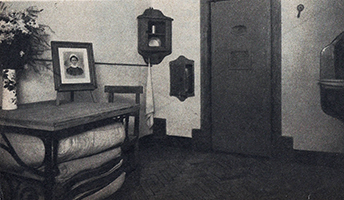 Edith Cavell's cell, St Gilles prison Edith Cavell's cell, St Gilles prison |
| 1915 – the trial TOP |
7th October 1915 – Edith Cavell and her companions in the escape network were brought before a military tribunal. This tribunal had been set up by the German military authorities in the Belgian Senate Chamber. Edith faced her accusers in civilian clothes, determined not to bring her profession into disrepute. The charge against her was "conducting soldiers to the enemy". When questioned about this she replied: "My preoccupation has not been to aid the enemy but to help the men who applied to me to reach the frontier. Once across the frontier they were free". The trial of all the thirty-five accused took just two days. None of the accused was allowed proper legal representation. There was no question of Edith being found "not guilty". She had admitted what she had done. The only question was the severity of the sentence the tribunal would impose. The decision was in the hands of the Military Governor of Brussels, General von Sauberzweig who had participated in the invastigation of the reign of terror in Belgium. He was bitter because his son had been blinded fighting the British. Friday 8th October 1915 – The trial ends. By his time diplomatic moves by neutral America, Spain and The Netherlands were under way to plead for clemency. Monday 11th October 1915 – Sentences passed. Edith Cavell, Philippe Baucq, Louise Thulliez, a French teacher from Lille, Countess Jeanne de Belleville and Louis Séverin, a Belgian pharmacist, are sentenced to death. The others received varying prison sentences. Hugh Gibson of the American Embassy (Ambassador Brand Whitlock was ill) enlisted the help of the Spanish Ambassador, the Marquis de Villalobar and the The Netherlands ambassador, Maurits Van Vollenhoven to once again appeal for clemency. General von Sauberzweig proved inflexible and informed Gibson the executions would take place the next morning. It was now midnight and Gibson realised that there was nothing more he could do.  The Belgian Senate busts of the Marquis de Villalobar, Brand Whitlock and Maurits Van Vollenhoven |
| 11th October 1915 – Edith's final hours TOP |
Edith learned of her fate at 20h30 on 11th October, being informed by the German Army Chaplain, Pastor Le Seur. She realised that she had only a few hours to live. Pastor Le Seur was able to arrange for the Anglican Chaplain, Reverend Stirling Gahan to visit Edith in her prison cell. Reverend Gahan arrived at the St Gilles prison at 22h00 and found Edith ready for the night. She had unfolded her bed and was in her dressing gown. They talked. She was calm and composed and she said to him: "I have no fear or shrinking. I have seen death so often that it is not strange or fearful to me. This time of rest has been a great mercy. Everyone here has been very kind. This I would say standing as I do in view of God and eternity, I realise that patriotism is not enough. I must have no hatred or bitterness towards anyone". Stirling Gahan had brought his Communion Set so together they took the bread and wine and said the Blessing before speaking the words of the hymn "Abide With Me". Gahan said to her before leaving that "We shall always remember you as a heroine and a martyr" to which she replied "Don't think of me like that. Think of me as a nurse who tried to do her duty". |
| 12th October 1915 – the execution | Early in the morning, probably around 6 o'clock, Edith Cavell and Philippe Baucq left their prison cells in the St Gilles prison. They were escorted down the prison corridors by guards. The German soldiers bowed their heads as this she walked by, quite erect and beautifully dressed. She completed her diary writing "Died at 07h on 12th October 1915". The journey across Brussels to the "Tir National” (National firing range) by car did not take long. A few weeping nurses had watched her leave the prison. At the place of execution the sentences relating to Edith Cavell and Philippe Baucq were read aloud. Pastor Le Seur said the Grace very quietly in English and led her to the execution post. Before her eyes were bandaged Le Seur saw that they were filled with tears. The priest then spoke briefly to Philippe Baucq before he too was led to his execution post. On the command the firing squads fired. Edith Cavell and Philippe Baucq died instantly. Thus Nurse Edith Cavell died. At the same moment Edith Cavell the heroine and martyr was born. Dr. Benn, a German chief medical officer in Brussels at the time, and a well known writer, wrote afterwards: "I was ordered to be present at the trial and execution of Edith Cavell. I followed the trial from first to last and frequently spoke with her. I certified her death, closed her eyes, and placed her body in the coffin. She was the bravest woman I ever met, and was in every respect the heroine her nation has made of her. She went to death with poise and with a bearing that is impossible to forget. She had, however, acted as a man towards the Germans, and deserved to be punished as a man”. Edith had been hurriedly buried at the rifle range where she was shot and a plain wooden cross put over her grave. (The shaft of this cross can be seen preserved at the back of Swardeston Church in her home village in Norfolk). |
| TOP | |
Theme 4 – The impact of Edith Cavell's execution
| After 12th October 1915 - The immediate aftermath of Edith Cavell's execution TOP |
General von Sauberzweig had estimated that if he hurried through the execution of Edith Cavell that would be the last anyone would hear about it. This was a substantial miscalculation on his part. The American Embassy and others made sure that the story was widely communicated and the press seized on it. The outcry that followed must have astounded the Germans and made them realise they had committed a serious blunder. The execution was used as propaganda by the allies, who acclaimed Nurse Cavell as a martyr and those responsible for her execution as murdering monsters. Sad to think that this was contrary to her last wishes. She did not want to be remembered as a martyr or a heroine but simply as "a nurse who tried to do her duty". The shooting of this brave nurse was not forgotten or forgiven and was used to sway neutral opinion against Germany and eventually helped to bring the U.S.A. into the war. Propaganda about her death resulted in army recruiting in The UK to double for eight weeks after her death was announced. The Germans realized too late that they had done themselves immeasurable harm. The Kaiser Wilhelm commanded that in future no woman was to be executed without his consent. Pleas for clemency for Louise Thulliez, Jeanne de Belleville and Louis Séverin from the Pope and from Alfonso XIII of Spain were upheld and the three were reprieved. |
Theme 5 – Events after World War One
| 1918 - recognition | At the end of the war King Albert I of The Belgians posthumously awarded Edith Cavell the "Cross of the Order of Leopold". The Belgian government awarded her the "Croix Civique" and France awarded her the "Légion d'Honneur". | ||
| 1919 – return home TOP |
17th March 1919 – Edith Cavell's body is exhumed. 13th May 1919 – Her coffin is escorted to the Gare du Nord in Brussels on a gun carriage escorted by a detachment of British troops sent from Cologne. (The idea for sending the troops came from Major B L Montgomery, later to become Field-Marshall Montgomery of Alamein). The streets of Brussels are lined with crowds of people. At the Gare du Nord the Reverend Stirling Gahan conducted a service before the coffin was taken by train to the port of Ostend where the Royal Navy destroyer, HMS Rowena, was waiting to carry her across the English Channel to Dover. During the voyage she had a military guard in full colours. Arriving at about six in the evening the body was transferred to the "Adder" and brought to the landing stage then escorted to the Marine Station and placed in a specially constructed funeral coach until the next morning. At Dover the St Mary's Society of Change Ringers rang for three hours and three minutes in honour of Edith Cavell. 14th May 1919 – The special train then travelled to London stopping at Folkestone and Ashford. The country stations through which the train passed were thronged with children and the men in the fields stood bareheaded as the train went by. The train arrived at Victoria Station at 11h00. Nurses walked in front of the gun carriage in the procession to Westminster Abbey. There was an escort of a hundred soldiers of all ranks. There were military bands and the streets were congested with people paying homage. The New York Times wrote the next day "No triumphant warrior and no potentate could have received a more impressive tribute than was paid today to the mortal remains of Miss Edith Cavell as they were borne through London". The memorial service in a crowded Westminster Abbey was attended by royalty and senior politicians. Her coffin was then taken by train to Norwich where she still rests in an area called "Life's Green" outside the south transept of Norwich Cathedral. |
||
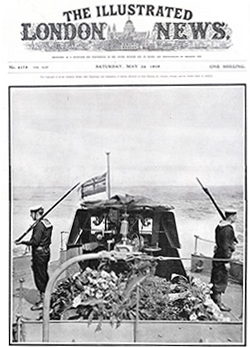 |
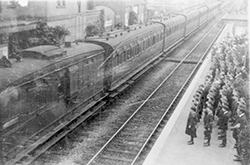 |
 |
|
| The Homecoming of Nurse Cavell On Board HMS Rowena May 13th, 1919 |
Edith Cavell carriage passing through Teynham Station Kent on May 14th, 1919 |
Interior of the Edith Cavell railway carriage at Bodium Kent | |
 |
 |
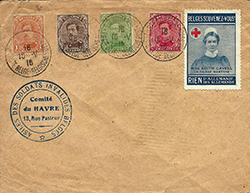 |
|
| TOP | Memorial Service in Westminster Abbey May 14th, 1919 |
Edith Cavell's coffin passing The House of Commons May 14th, 1919 |
Propaganda stamp 1916 |
Theme 6 – Memorials to Edith Cavell throughout the world
Many memorials and places bear Edith Cavell's name in many different countries that were moved to remember her.A sample of these is presented below.
| Belgium TOP |
|
||||
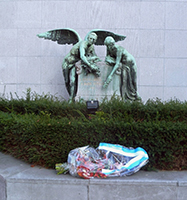 |
 |
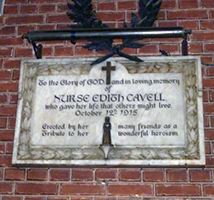 |
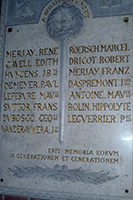 |
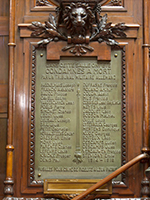 |
|
| Edith Cavell & Marie Depage memorial Brussels |
Edith Cavell headstone at the Edith Cavell Hospital, Brussels |
Memorial Plaque Holy Trinity Church, Brussels |
Memorial Plaque Eglise de l'Annonciation, Brussels | Memorial plaque in the Belgian Senate. Courtesy of the Senate, Guy Goossens | |
| UK |
|
||||
| TOP | 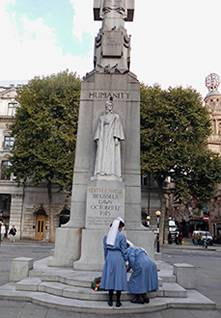 |
Edith Cavell statue, London | |||
| France TOP |
|
||||
| Portugal |
|
||||
| Canada |
|
||||
 |
Mount Edith Cavell, Canada | ||||
|
|||||
| Australia TOP |
|
||||
| New Zealand |
|
||||
| South Africa |
|
||||
| Mauritius Island |
|
||||
| India TOP |
|
||||
| Argentina |
|
||||
| Planet of Venus |
|
||||
| Rose |
|
||||
TOP |
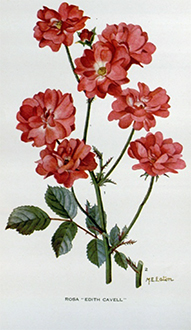 |
Edith Cavell Rose | |||
| Edith Piaf |  The parents of Edith Piaf, born on 19th December 1915, named their daughter in memory of Edith Cavell. The parents of Edith Piaf, born on 19th December 1915, named their daughter in memory of Edith Cavell. |
||||
Other items of interest:
| Films |
|
|
Play |
|
|
| Belgium |
|
|
| Selection of Books TOP |
|
|
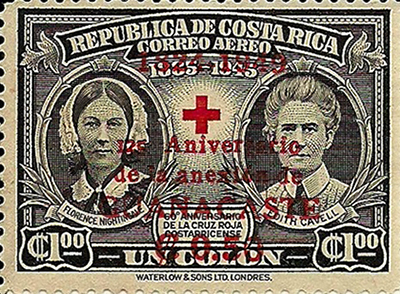 |
 |
|
| Costa Rica Red Cross stamp | Women of achievement stamp issue | |
Acknowledgements:
The archive of The Royal London Hospital
Norwich Cathedral Publications
The Norwich Edith Cavell website: edithcavell.org.uk
Edith Cavell by Rowland Ryder
Fatal Decision: Edith Cavell WW1 Nurse by Terri Arthur
Edith Cavell by Diana Souhami
Hugh Perks
TOP
